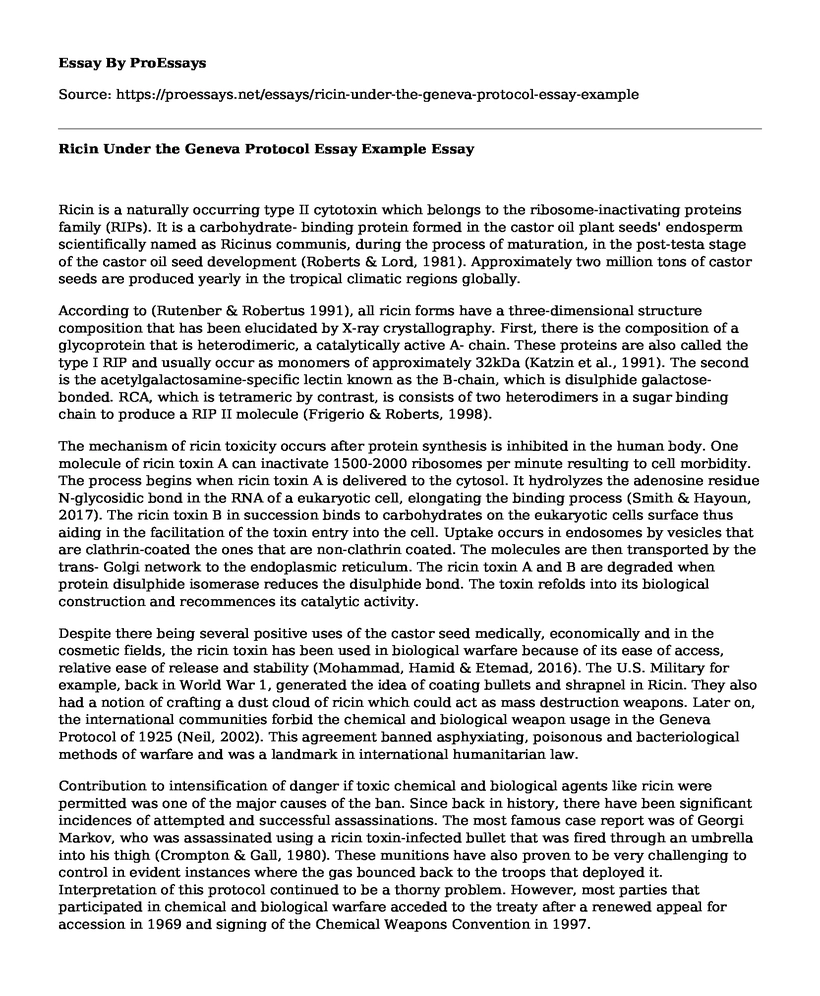Ricin is a naturally occurring type II cytotoxin which belongs to the ribosome-inactivating proteins family (RIPs). It is a carbohydrate- binding protein formed in the castor oil plant seeds' endosperm scientifically named as Ricinus communis, during the process of maturation, in the post-testa stage of the castor oil seed development (Roberts & Lord, 1981). Approximately two million tons of castor seeds are produced yearly in the tropical climatic regions globally.
According to (Rutenber & Robertus 1991), all ricin forms have a three-dimensional structure composition that has been elucidated by X-ray crystallography. First, there is the composition of a glycoprotein that is heterodimeric, a catalytically active A- chain. These proteins are also called the type I RIP and usually occur as monomers of approximately 32kDa (Katzin et al., 1991). The second is the acetylgalactosamine-specific lectin known as the B-chain, which is disulphide galactose-bonded. RCA, which is tetrameric by contrast, is consists of two heterodimers in a sugar binding chain to produce a RIP II molecule (Frigerio & Roberts, 1998).
The mechanism of ricin toxicity occurs after protein synthesis is inhibited in the human body. One molecule of ricin toxin A can inactivate 1500-2000 ribosomes per minute resulting to cell morbidity. The process begins when ricin toxin A is delivered to the cytosol. It hydrolyzes the adenosine residue N-glycosidic bond in the RNA of a eukaryotic cell, elongating the binding process (Smith & Hayoun, 2017). The ricin toxin B in succession binds to carbohydrates on the eukaryotic cells surface thus aiding in the facilitation of the toxin entry into the cell. Uptake occurs in endosomes by vesicles that are clathrin-coated the ones that are non-clathrin coated. The molecules are then transported by the trans- Golgi network to the endoplasmic reticulum. The ricin toxin A and B are degraded when protein disulphide isomerase reduces the disulphide bond. The toxin refolds into its biological construction and recommences its catalytic activity.
Despite there being several positive uses of the castor seed medically, economically and in the cosmetic fields, the ricin toxin has been used in biological warfare because of its ease of access, relative ease of release and stability (Mohammad, Hamid & Etemad, 2016). The U.S. Military for example, back in World War 1, generated the idea of coating bullets and shrapnel in Ricin. They also had a notion of crafting a dust cloud of ricin which could act as mass destruction weapons. Later on, the international communities forbid the chemical and biological weapon usage in the Geneva Protocol of 1925 (Neil, 2002). This agreement banned asphyxiating, poisonous and bacteriological methods of warfare and was a landmark in international humanitarian law.
Contribution to intensification of danger if toxic chemical and biological agents like ricin were permitted was one of the major causes of the ban. Since back in history, there have been significant incidences of attempted and successful assassinations. The most famous case report was of Georgi Markov, who was assassinated using a ricin toxin-infected bullet that was fired through an umbrella into his thigh (Crompton & Gall, 1980). These munitions have also proven to be very challenging to control in evident instances where the gas bounced back to the troops that deployed it. Interpretation of this protocol continued to be a thorny problem. However, most parties that participated in chemical and biological warfare acceded to the treaty after a renewed appeal for accession in 1969 and signing of the Chemical Weapons Convention in 1997.
Conclusion
Biological and chemical weapons have marked horrific and lethal consequences. Ban of such toxins as ricin has brought about stability and humanity all over the world. More so, use of such weapons has been outlawed by the universal opinion of civilized humanity.
References
Crompton, R., & Gall, D. (1980). Georgi Markov- death in a pellet. Medico-Legal Journal 48(2), 51-62
Frigerio, L., & Roberts, L. M. (1998). The enemy within ricin and plant cells. Journal of experimental botany, 49(326), 1473-1480.
Katzin, B. J., Collins, E. J., & Robertus, J. D. (1991). Structure of ricin Achain at 2.5 A. Proteins: Structure, Function, and Bioinformatics, 10(3), 251-259.
Metcalfe, N. (2002). A short history of biological warfare. Medicine, Conflict and Survival, 18(3), 271-282.
Moshiri, M., Hamid, F., & Etemad, L. (2016). Ricin Toxicity: Clinical and Molecular Aspects. Reports of Biochemistry & Molecular Biology, 4(2), 60-65.
Roberts, L. M., & Lord, J. M. (1981). Protein biosynthetic capacity in the endosperm tissue of ripening castor bean seeds. Planta, 152(5), 420-427.
Rutenber, E., & Robertus, J. D. (1991). Structure of ricin Bchain at 2.5 A resolution. Proteins: Structure, Function, and Bioinformatics, 10(3), 260-269.
Smith, M. E., & Hayoun, M. A. (2017). Toxicity, Ricin.
Cite this page
Ricin Under the Geneva Protocol Essay Example. (2022, Jul 18). Retrieved from https://proessays.net/essays/ricin-under-the-geneva-protocol-essay-example
If you are the original author of this essay and no longer wish to have it published on the ProEssays website, please click below to request its removal:
- How Alternative Forms of Drugs Can Be Considered a Viable Alternative to Conventional Medicine?
- The Five Patterns of Knowledge - Paper Example
- Acute Myocardial Infarction Essay Example
- Alberta Project APPLE Schools: A Health Promotion Program - Essay Sample
- Essay Example on Latest Update on Covid-19 Pandemic: What You Need to Know
- Article Review Example on Notes from Under the Dome: Pro-Life Stance by George McKenna
- Nurses' Perspectives on Bed Enclosure - Free Article Review







